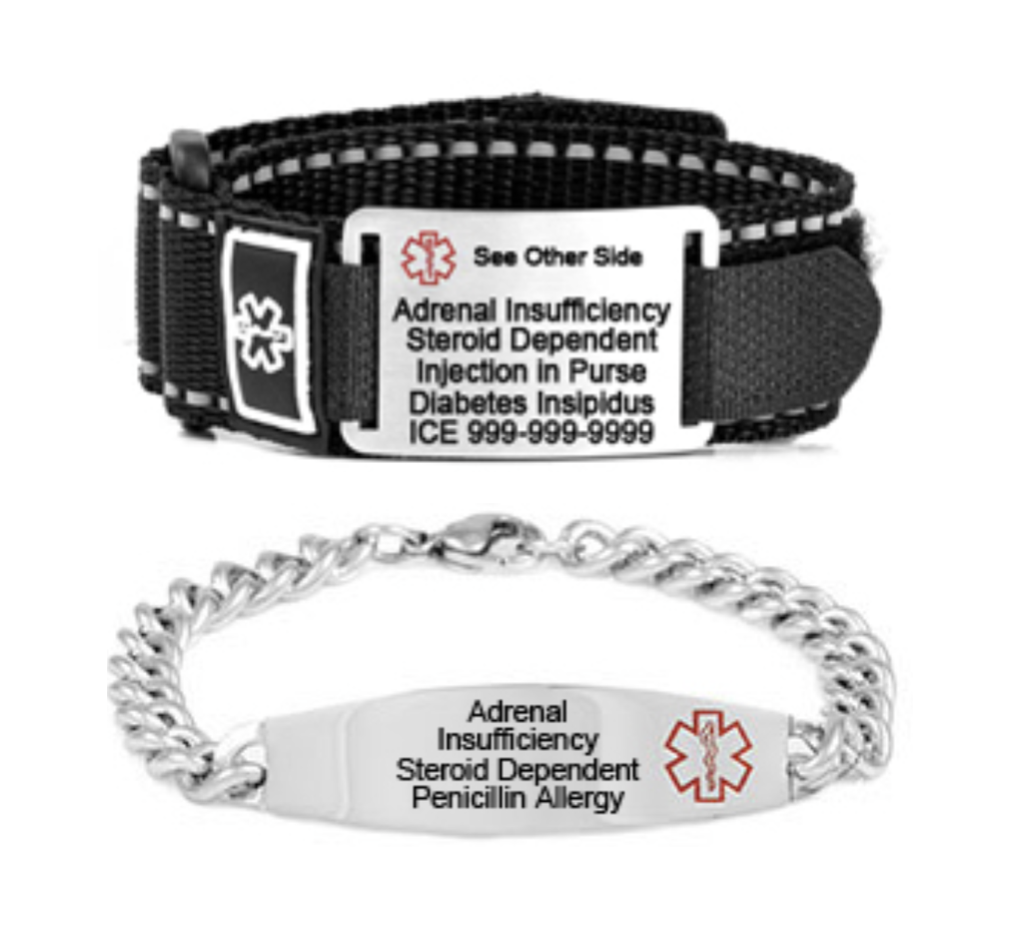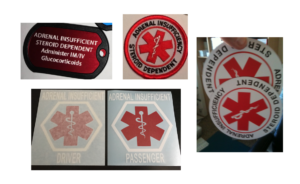Emergency
Info
Signs and Symptoms of Adrenal Crisis: Not all symptoms will be present
- Shock-like symptoms
- Nausea or vomiting/diarrhea
- Lethargy/listlessness
- Neurological deficits: behavior changes, confusion, difficulty speaking, slurred speech
- Pale, cold, clammy skin, shivering
- Rapid pulse and/or breathing
- Headache/dizziness
- Fever/infections
- Low blood sugar
- Low OR high blood pressure
- Pain: abdominal, back, flank, legs.
- Seizures
- Cardiovascular collapse/stroke
Low sodium levels can lead to delirium and abnormal brain function. As a result patients may seem to be under the influence. This is a sign of adrenal crisis and must be treated immediately.
An Adrenal Crisis is LIFE THREATENING
An adrenal crisis is life threatening and needs prompt treatment. If you think you or your loved one is experiencing crisis symptoms do not wait! CALL 911.
If you have an emergency injectable use it per your endocrinologist’s instructions, and get to the ER! Contact your endo to alert him/her so they can inform the ER staff of your imminent arrival.
Emergency Protocols: In the USA Emergency Medical Providers (EMTs and Paramedics must have a protocol in place before they are able to treat an adrenal crisis. Included is a sample protocol.
1. Administer/assist with patient provided emergency injection. If not available use one locally approved steroid IM/IV. Hydrocortisone is the preferred emergency glucocorticoid. Be aware, many patients also lack mineralocorticoid coverage.



2. Check a capillary blood glucose. If blood glucose is less than 70 mg/dl. refer to local diabetic protocols.
3. Administer NS fluids per local protocol. Refer to local hypotension shock protocol.
4. Refer to local cardiac arrest protocol.
BE PREPARED!
Communicate with emergency providers and alert others to your condition.

Use your Phone
Make a screen saver for your phone.
Create a contact on your phone called ICE: In Case of Emergency. Put your emergency information down including contact phone numbers for family and endocrinologist.
Free Print files
Download files you can print yourself. (Personal use only, not for resale.)
Signs & Symptoms business sized cards
2″ Round Adrenal Insufficiency:Steroid Dependent
Emergency Medications Inside about about 1.5″ x 3″ (10) per page.

Get a medical Id
A medical ID is the first step in letting emergency providers know what to do when you can’t speak for yourself. Wear your Medical ID at all times. Make sure it looks like a medical ID! EMTs report that IDs that look like more like jewelry aren’t noticed. EMTs also say they look for a necklace or bracelet type ID. Other types such shoe tags may not be seen.
Suggested Text: ADRENAL INSUFFICIENCY: STEROID DEPENDENT
Other helpful information to add to a medical ID includes: the endocrinologist’s emergency or on call number, patient’s date of birth, and emergency contact numbers. Most EMS trainings and protocols use the term adrenal insufficiency.
If room allows and you would like to list the specific condition causing your AI you may add that as well. However since most conditions causing adrenal insufficiency are rare EMTs may not have protocols or training on your specific condition.
MedicAlert, Road ID, and Sticky J all have good options to choose from.
Parents start making your child wear an ID as soon as soon they are diagnosed or when they are big enough for one to fit.
Tattoos, even if they are on the wrist, are not guaranteed to be noticed by EMTs. It’s about 50/50 from those asked. This may change in the future as medical tattoos become more popular.

Other ideas
We have listed many of resources we offer in our store that you may find helpful. Shop at the AIU Store
- Fill out the mini-brochure and keep it in your wallet.
- Put emergency/crisis cards in your wallet and give them to your friends and family.
- Attach patches or ID covers to backpacks, car seats, or seat belts
- Use a rescue facts seat belt cover.
- Place a magnet on your refrigerator or a decal by the front door
- Place a magnet on the car door next to the adrenal insufficient passenger
- Use temporary tattoos as a supplement for a child’s ID while traveling (in case they lose it on a trip)
Keep your kit with you
Your injection kit should contain
- Emergency Instructions from your physician.
- Two vials of Solu-cortef or other emergency steroid prescribed by your doctor. (in case one fails)
- Syringes – Be sure to ask your physician to write a script for the syringe as well, some members have said their pharmacist won’t give one without a script. A syringe large enough to hold your emergency dose with a needle long enough to reach a muscle. We suggest you ask for 2 vials and 4 syringes, in case of malfunction or user error. If needles come separately from the syringe ask for two. Sometimes the needle may bend when drawing up liquid and be harder to inject.
- Printed injection instructions.
- Sterilizing wipes and bandaids
- Many also include additional oral medication and anti nausea medicine to their kits.


A resource from the Sydney Children’s Hospital in Australia.
ADRENAL INSUFFICIENCY – EMERGENCY MANAGEMENT PRACTICE GUIDELINE
More resources on the injection
An adrenal crisis can come on quickly. Not only must you learn how to inject, but you should be ready to teach others how to help if you are unable to self-inject.
Ask your endocrinologist to train you on how and when to give the injection.
Don’t be afraid, as the consequences of delaying the injection can be dire. Even children as young as 8 or 9 have been trained.
Many of our member keep their expired vials of Solu-Cortef® or other prescriptions for training purposes. Below you’ll find links to few different videos and some written instructions.
Injection Instructions Video: This youtube video by the Succeed Clinic in OK walks you through the steps to inject. Although the video was made for those with Congenital Adrenal Hyperplasia the instructions on how to inject are the same for anyone. Be sure to ask your physician about the circumstances in which you would need an injection.
Written Injection Instructions from the Memorial Slone Kettering Cancer Center. They also have Video Instructions.

Using the Protocol Map
Our map currently covers the USA only. Contact us if you have a protocol from another country you’d like us to add.
These are protocols that have been found by AIU or sent to AIU by our members. The list may or may not be accurate as things can change. We highly recommend printing any protocol you find and taking it to your closest EMS station to be sure it’s still in effect. We would greatly appreciate any information about protocols that have been updated or ones that may be in effect, but are not shown on the map.
AIU collaborates and supports Danny’s Dose in their work to create inclusive protocols for all those with specialty medications. Learn more about Danny’s Dose.
Click on the icon to read more. Each protocol can be downloaded from media fire. If you unable to download try changing browsers. If you prefer to access through google sheets click here.
Blue Ambulances = EMS Protocols
Yellow = States which have passed Danny’s Dose Legislation
Purple = Protocols or bills that may not specifically say adrenal insufficiency, but are written in a way that we hope will still cover all with AI.
You've Got This!

